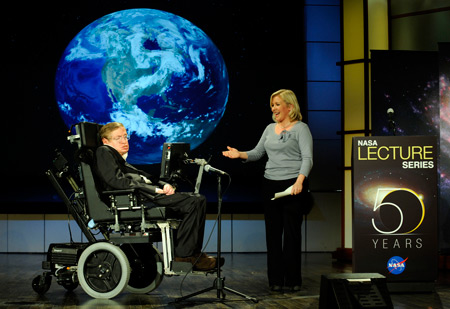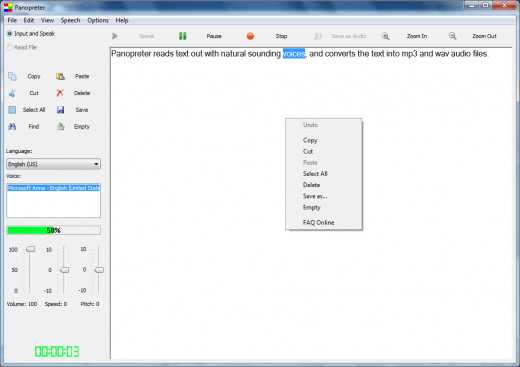How does Stephen Hawking Talk?


Check out my Blog!
- Artois52 blog - It's just my thoughts
Making sense of life the best way that I can; with daily posts, almost, on anything that catches my imagination and interest.
A brief history of speech synthesis
Voice synthesis has fascinated humans for centuries and the first attempts to create mechanical speech were made long before the advent of the computer. Talking machines appeared, in legend, as far back as 1003 AD with mentions in literature of Brazen Heads, which were brass automatons, in the form of a human head, that were said to be able to answer any question answered of them.
Various attempts to create artificial speech continued through the ages, including a bellows operated speech synthesiser designed by Wolfgang von Kempelen of Hungary called the "acoustic-mechanical speech machine". This machine included an artificial tongue and lips and was able to pronounce all the letters of the alphabet.
The first computer speech systems came about in the 1950s and the first viable text to speech systems was created at the Electrotechnical Laboratory in Japan, in 1968. Through the 1970s and eighties, the technology continued to develop and speech synthesis became available in many different devices including; calculators for the blind, arcade games and toys to help children with their spelling.
_______________________________________________________________
Please do share, tweet, pin, or post, if you like this article.
Many thanks
_______________________________________________________________

More articles from Artois52
- How was our solar system created?
Our solar system is amazing, wonderful and quite beautiful. But, where the heck did it all come from? Read on, and find out how scientists believe that the solar system was formed. - Fascinating facts about the Hubble Telescope
The Hubble Telescope, launched in 1990, has provided us with amazing images of the Universe. Here are nine facts about the Hubble Telescope and some of those incredible images that it has captured.
Stephen Hawking’s synthesised voice
The most famous of all users of voice synthesis software is, of course Stephen Hawking. The world renowned physicist, who came to public notice when his book, A Brief History of Time, which was in the British Sunday Times best sellers list for over 235 weeks, was published.
Regarded as one of the most brilliant physicist’s since Einstein, Stephen Hawking contracted motor neurone disease in 1963; a progressive disease that affects a person’s ability to control their muscles including those used for walking, talking, swallowing and general movement. Despite the fact that Hawking, at the time, was only given two years to live, he continued on in his brilliant career aided by his electric wheelchair and speech synthesis.
Hawking’s current computer system, which he has used since 1997, is based upon a tablet computer that is mounted on the arm of his wheelchair. Because he now has no movement in his hands and arms, he controls the computer by giving it commands through movements in his cheek. These movements are picked up by an infrared detector that is mounted on his glasses.
He ‘Types’ via a software application called EZ Keys. This application displays a keyboard on his screen and a cursor runs across the letters until Hawking indicates the letter to stop, with his cheek. As he selects the letters, the software uses a predictive algorithm to suggest words, and he then selects the required word from those.
Once he has completed his text, it is sent to a text to speech synthesiser that converts into his now famous computerised voice. When Stephen Hawking gives lectures, or makes speeches, he prepares them in advance and then replays them using the text to speech software.
How Stephen Hawking talks - in his own words
How text to speech software works

Text to speech software works on one of two basic ways. The first looks at the spelling of a word and then refers to a dictionary of pronunciations of words to find the exact spoken equivalent of that word. The second method looks at the component of a word to look up the pronunciation of those components, very much like the way that children are taught to read by ‘sounding out’ a word. Most modern systems now use a combination of both systems, partly to save on computer storage space that is needed for what could become a massive dictionary of word pronunciations.
However, text speech software isn’t quite as simple as simply looking things up in a dictionary; there are many other difficulties that good text to speech software has to overcome. For example, how would you pronounce the word ‘of’? And it’s not just the contextual pronunciations that it has to overcome; it’s also the pronunciation of things like numbers that are problematic. For example; is 1958, nineteen fifty eight, one nine five eight, or is it one thousand nine hundred and fifty eight?

Modern applications of text to speech software
Synthesized speech has come a long way since the days of a bellow driven mechanical speech machine with artificial lips and tongue, and is now readily available and affordable for anyone. For example, you can buy and download text to speech software that read web pages, word documents and other file formats from as little as $30.00 from websites like http://www.panopreter.com/
Now that the software is available so inexpensively, it can be used for many different purposes. As well as being a great aid for the visually impaired, it can also be used by people learning languages, people with reading difficulties, or simply as a way of studying, learning a speech or listening to text, safely, while you drive.

Where next for Speech Synthesis?
Science fiction has long played with the idea of talking computers. In fact, it was when Arthur C Clarke’s friend and colleague, John Pierce, demonstrated an IBM computer singing "Daisy Bell" that Clarke got the idea for the closing scene of his science fiction novel, 2001: A Space Odyssey, where the HAL 9000 computer sings the same song.
Although we have a long way to go with real artificial intelligence, with all the advances in speech recognition software and speech synthesis software that have been made over the years, perhaps something approaching a HAL 9000 isn’t as far away as we might think?
_______________________________________________________________
_______________________________________________________________






